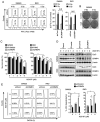Collapsin response mediator protein 4 enhances the radiosensitivity of colon cancer cells through calcium‑mediated cell signaling
- PMID: 33655336
- PMCID: PMC7877015
- DOI: 10.3892/or.2021.7957
Collapsin response mediator protein 4 enhances the radiosensitivity of colon cancer cells through calcium‑mediated cell signaling
Abstract
Radiation therapy is an effective treatment against various types of cancer, but some radiation‑resistant cancer cells remain a major therapeutic obstacle; thus, understanding radiation resistance mechanisms is essential for cancer treatment. In this study, we established radiation‑resistant colon cancer cell lines and examined the radiation‑induced genetic changes associated with radiation resistance. Using RNA‑sequencing analysis, collapsin response mediator protein 4 (<em>CRMP4</em>) was identified as the candidate gene associated with radiation sensitivity. When cells were exposed to radiation, intracellular Ca2+ influx, collapse of mitochondrial membrane potential, and cytochrome c release into the cytosol were increased, followed by apoptosis induction. Radiation treatment‑ or Ca2+ ionophore A23187‑induced apoptosis was significantly inhibited in <em>CRMP4</em>‑deficient cells, including radiation‑resistant or <em>CRMP4</em>‑shRNA cell lines. Furthermore, treatment of <em>CRMP4</em>‑deficient cells with low levels (<5 µM) of BAPTA‑AM, a Ca2+ chelator, resulted in radiation resistance. Conversely, Ca2+ deficiency induced by a high BAPTA‑AM concentration (>10 µM) resulted in higher cell death in the <em>CRMP4</em>‑depleted cells compared to <em>CRMP4</em>‑expressing control cells. Our results suggest that <em>CRMP4</em> plays an important role in Ca2+‑mediated cell death pathways under radiation exposure and that CRMP4 may be a therapeutical target for colon cancer treatment.
Keywords: CRMP4; radioresistance; colon cancer; calcium influx; mitochondrial membrane potential.
Conflict of interest statement
The authors declare that they have no competing interests.
Figures







References
MeSH terms
Substances
LinkOut - more resources
Full Text Sources
Other Literature Sources
Molecular Biology Databases
Miscellaneous

